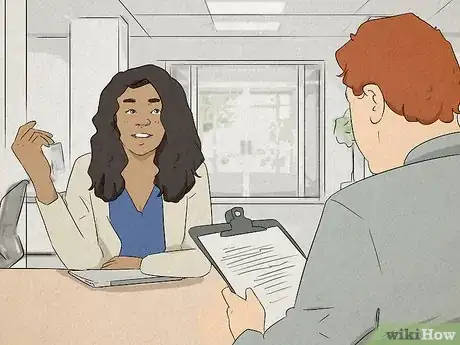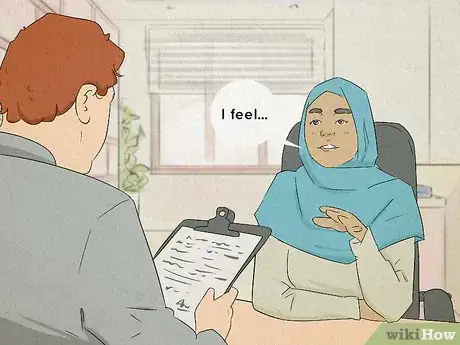This article was co-authored by Jessica George, MA, CHt and by wikiHow staff writer, Janice Tieperman. Jessica George is a Marriage and Family Therapist, Certified Professional Master Life Coach, and Co-Founder of Evolve Therapy Coaching based in Glendale, California. With more than 20 years of experience, she specializes in hybrid therapy and coaching services, couples counseling, and clinical hypnotherapy. Jessica holds a Bachelor’s degree from The University of California, Santa Barbara and an MA in Counseling Psychology and Talk Therapy from Ryokan College. Jessica is trained in the Imago technique and the Gottman method for couples therapy. She also earned a Professional Life-Coach Certification from The Fowler Academy and an Infinite Possibilities Relationship Certification. She is a member of the International Board of Coaches and Practitioners (IBCP).
There are 13 references cited in this article, which can be found at the bottom of the page.
This article has been viewed 12,124 times.
Nothing’s worse than that pit in your stomach when you’re caught in the crosshairs of a conflict, especially when you’re at work. How are you supposed to make things better without completely caving in to the other party? There’s no need to worry. We’ve put together plenty of easy, practical tips and suggestions to give you a great shot at making things right.
Steps
Expert Q&A
-
QuestionHow do you talk out a problem?
 Jessica George, MA, CHtJessica George is a Marriage and Family Therapist, Certified Professional Master Life Coach, and Co-Founder of Evolve Therapy Coaching based in Glendale, California. With more than 20 years of experience, she specializes in hybrid therapy and coaching services, couples counseling, and clinical hypnotherapy. Jessica holds a Bachelor’s degree from The University of California, Santa Barbara and an MA in Counseling Psychology and Talk Therapy from Ryokan College. Jessica is trained in the Imago technique and the Gottman method for couples therapy. She also earned a Professional Life-Coach Certification from The Fowler Academy and an Infinite Possibilities Relationship Certification. She is a member of the International Board of Coaches and Practitioners (IBCP).
Jessica George, MA, CHtJessica George is a Marriage and Family Therapist, Certified Professional Master Life Coach, and Co-Founder of Evolve Therapy Coaching based in Glendale, California. With more than 20 years of experience, she specializes in hybrid therapy and coaching services, couples counseling, and clinical hypnotherapy. Jessica holds a Bachelor’s degree from The University of California, Santa Barbara and an MA in Counseling Psychology and Talk Therapy from Ryokan College. Jessica is trained in the Imago technique and the Gottman method for couples therapy. She also earned a Professional Life-Coach Certification from The Fowler Academy and an Infinite Possibilities Relationship Certification. She is a member of the International Board of Coaches and Practitioners (IBCP).
Certified Professional Master Life Coach Try the Imago technique! One person speaks at a time, while the other person sits and absorbs. Before it's the other person's time to speak, they narrate back what they just heard—it's a great way to slow down conversation and communication. Once people are heard in a safe and mature manner, they can then begin to work towards a resolution.
Try the Imago technique! One person speaks at a time, while the other person sits and absorbs. Before it's the other person's time to speak, they narrate back what they just heard—it's a great way to slow down conversation and communication. Once people are heard in a safe and mature manner, they can then begin to work towards a resolution.
References
- ↑ https://www.pon.harvard.edu/daily/conflict-resolution/conflict-resolution-strategies/
- ↑ Jessica George, MA, CHt. Certified Professional Master Life Coach. Expert Interview. 11 February 2022.
- ↑ https://hr.utexas.edu/current/services/problem-solving#focus
- ↑ https://blink.ucsd.edu/HR/supervising/conflict/handle.html#1.-Talk-with-the-other-person.
- ↑ Liana Georgoulis, PsyD. Licensed Psychologist. Expert Interview. 6 September 2018.
- ↑ https://www.helpguide.org/articles/relationships-communication/conflict-resolution-skills.htm
- ↑ Jessica George, MA, CHt. Certified Professional Master Life Coach. Expert Interview. 11 February 2022.
- ↑ Liana Georgoulis, PsyD. Licensed Psychologist. Expert Interview. 6 September 2018.
- ↑ https://ggia.berkeley.edu/practice/active_listening
- ↑ Jessica George, MA, CHt. Certified Professional Master Life Coach. Expert Interview. 11 February 2022.
- ↑ https://adm.viu.ca/workplace-conflict/communicating-in-conflict
- ↑ https://www.helpguide.org/articles/relationships-communication/conflict-resolution-skills.htm
- ↑ https://www.helpguide.org/articles/relationships-communication/managing-conflicts-with-humor.htm
- ↑ Jessica George, MA, CHt. Certified Professional Master Life Coach. Expert Interview. 11 February 2022.
- ↑ https://psycnet.apa.org/record/2016-17980-002
- ↑ Liana Georgoulis, PsyD. Licensed Psychologist. Expert Interview. 6 September 2018.
- ↑ https://ggia.berkeley.edu/practice/making_an_effective_apology
- ↑ https://www.waldenu.edu/news-and-events/walden-news/2017/0530-whats-your-conflict-management-style
- ↑ https://managementweekly.org/thomas-kilmann-conflict-resolution-model/
- ↑ https://www.waldenu.edu/news-and-events/walden-news/2017/0530-whats-your-conflict-management-style
- ↑ https://www.waldenu.edu/news-and-events/walden-news/2017/0530-whats-your-conflict-management-style
- ↑ https://www.waldenu.edu/news-and-events/walden-news/2017/0530-whats-your-conflict-management-style
- ↑ https://www.waldenu.edu/news-and-events/walden-news/2017/0530-whats-your-conflict-management-style
- ↑ https://www.helpguide.org/articles/relationships-communication/conflict-resolution-skills.htm










































































